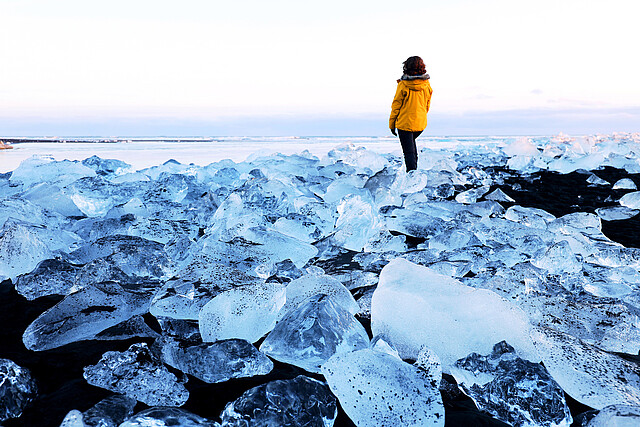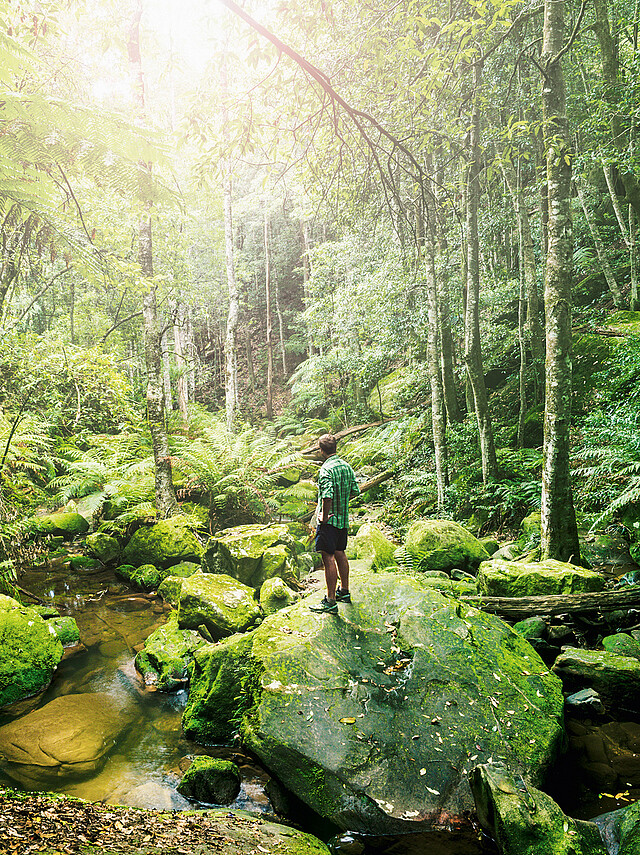In search of good air
We only notice how valuable clean air is when it is absent. When particulate matter and smog determine our lives in the cities or the countryside and endanger the health of millions of people. The more routine this condition becomes, the more we yearn after regions with particularly good air. So we decided to search out some unique places where you can breathe deeply without a care.
Iceland, 64°N, 22°W
Distant land, clean air
Behind this house, there is nothing for miles. What may sound like the exaggeration of an exhausted wanderer is reality here. The hilly landscape is wide, rough and somehow unreal. The air smells naturally pure, reminiscent of fresh lake water. Finally, you can breathe deeply again – something that city dwellers and hay fever sufferers in particular can no longer take for granted.

Lots of sheep, little particulate matter
The clean air is particularly typical of Iceland. Only a little more than 3 inhabitants per square kilometer live on the sparsely populated island. By way of comparison, the equivalent figure for Germany is 230. Fishing and sheep farming still characterize the country’s economy today and there are very few industrial plants. As a result, hardly any industrial particulate matter, diesel soot or combustion particles are released on the island.
All clear for allergy sufferers
In Iceland, comparatively little pollen can be found in the air. This is because there are barely any trees, much of the island is covered in nothing more than mosses and lichens, and grasses bloom over a relatively short period of time. For people affected by city smog or a pollen allergy, the clean air significantly boosts wellbeing and quality of life. Not surprisingly, the Doctors’ Association of German Allergists recommends the country as an ideal destination for allergy sufferers.
“Iceland is considered particularly good for allergy sufferers. There are hardly any trees to release their pollen, the grasses are short and air pollution is low.” Source: Doctors’ Association of German Allergists

Antarctic, 80°S, 77°O
Searching for stars in the eternal ice
In July, when it is winter in the southern hemisphere, the temperatures on the high plateau Dome Argus often fall below minus 70 degrees Celsius. Even thick down jackets and fur hats barely protect against the cold, thousands of kilometers away from the next settlement. But it is precisely the temperature and seclusion of the place that makes it ideal for astronomers. The view of young stars and galaxies formed shortly after the Big Bang is better here than anywhere else on earth.
Particles fracture the light
The very cold and dry air contains hardly any particles. Even ice crystals can barely be found in the air due to the minimal wind movements near the South Pole. Diesel soot, pollen or other particles would fracture the starlight on its path through the atmosphere. For astronomers, this means that the fewer particles present in the air, the sharper and higher quality the view of the night sky.
Isolated from the rest of the world
Due to the absence of particulate matter, the air in the Antarctic is in a kind of preindustrial state. This is attributable to the strong westerly winds. Known as the “Roaring Forties”, “Furious Fifties” and “Screaming Sixties”, they howl between the 40th and 70th degrees of latitude. These winds form a natural shield around the eternal ice and keep particles from lower latitudes at bay. Aside from a few ice crystals and sea salt particles, the air here contains hardly any particles and is uniquely clear.
Canada, 50°N, 123°W
Eliminating particulate matter
Canada – the land where picturesque lake landscapes, rugged mountain ranges and wild tundra meet. Most of the forests are still virgin forests and untouched by humans. The air is above average cleanliness right across the country. A local startup is even selling Rocky Mountain air worldwide to inhabitants of smog-plagued cities in particular, who long for pure air as it can still be found in Canada.

Committed to good air
The Canadian government is committed to protecting the clean air. From 2030 onwards, there will be a blanket ban on extracting energy from coal, as incineration generates large quantities of particulate matter and pollutants. Thorough filtration of industrial exhaust air via high-performance filter systems is intended to further reduce national particulate matter emissions. The country is also investing in clean mobility. In the coming years, large sums of money will be made available to expand the charging infrastructure for e-cars.
Measurably clean
The air in Canada not only has a subjectively perceptible quality. The World Health Organization (WHO) records global air purity at numerous monitoring stations. According to the WHO, average values for the PM10 spectrum up to the threshold value of 20 μg/m3 are not harmful to human health. With an average of just 7 μg/m3, the Powell River measuring station on Canada’s west coast has one of the world’s lowest concentrations of airborne particles.
Diagram (PM10 in µg/m³)
| Powell River (Canada) | 7 |
|---|---|
| Montreal (Canada) | 16 |
| Delhi | 229 |
| Heidelberg | 20 |
| Cairo | 179 |
| Shanghai | 84 |
| Worldwide* | 83 |
| Harmless acc. WHO | 20 (represent as a cross line) |
| EU threshold value | 40 (represent as a cross line) |
* Relative to the average population. That is, the value of the metropolis Delhi weighs much more heavily in the calculation than the value of a rural region.
Source: WHO Global Urban Ambient Air Pollution Database 2016
Tasmania, 43°S, 146°O
The island that guarantees fresh air
Here he sits, between the lush green leaves. The cockatoo stares at the SLR camera with a mixture of curiosity and madness. He has already flown at speed into the lens once. Since then, he has been sitting here and staring. Nobody knows what will happen next. Better take another deep breath.
Shot in the best light
Tasmania is not only popular with photographers from around the world for its vibrant and diverse flora and fauna. They love the air too, because it modifies the light and thus ensures very special photos. The calculation is simple: the fewer particles there are in the air, the clearer and more brilliant the shots. Particles like diesel soot or fungal spores fracture the light and create a diffuse impression on the pictures. Photographers particularly treasure the combination of spectacular subjects and perfect conditions on the island.
The cleanest air in the world
In the extreme northwestern corner of Tasmania, where 15,000 kilometers of sea lie beyond the horizon before Patagonia arrives, stands the Cape Grim measuring station. As part of the UN’s “Global Atmosphere Watch” program, the island has been certified as having the cleanest air in the world, thanks to the air values at Cape Grim. One reason for this is the “Roaring Forties” westerlies that blow across those 15,000 kilometers of sea before supplying Tasmania with abundant fresh air. The fact that Tasmania’s air is fundamentally clean has been proved by other monitoring programs, such as the World Air Quality Index project and the network of air measurement stations in Tasmania.
Are you curious to know what the air quality is like in your region? The online platform of the World Air Quality Index project provides real-time values for particulate matter, ozone or nitrogen oxides from stations worldwide.












